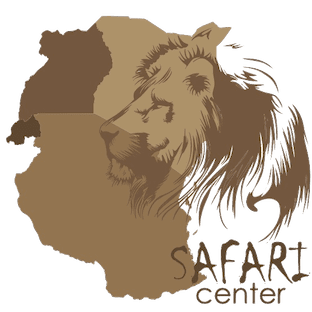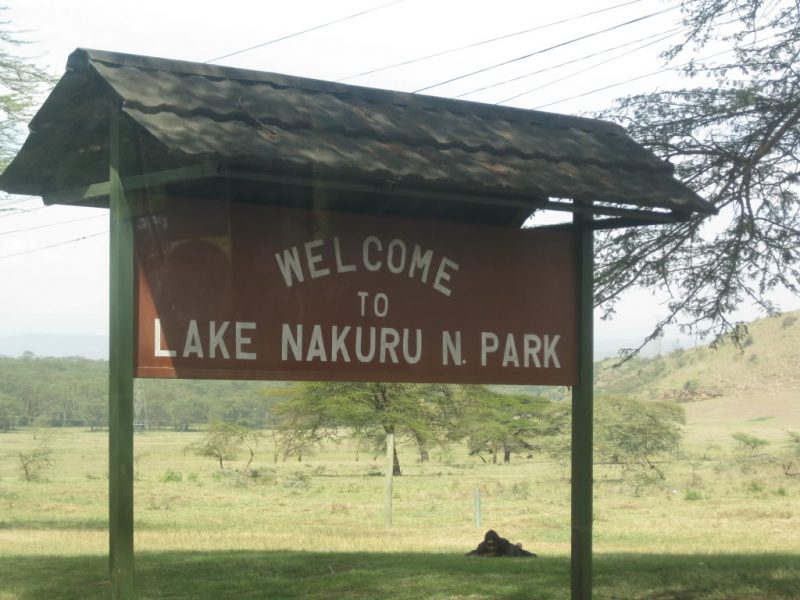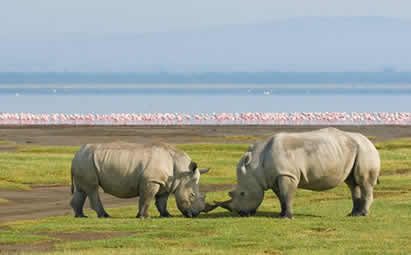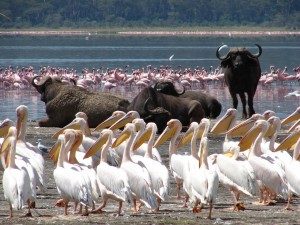A Game Drive Through Nakuru National Park
The beautiful and picturesque Nakuru, located 164 km from Nairobi, rises from the floor of the East African Rift Valley and is surrounded and dominated by an undulating terrain of acacia woodlands, open rough grassland and euphorbia forest, characteristic of the vegetation in the rift valley. Nakuru encloses the park, the lake, and its adjacent lands. The word Nakuru in the Maa language of Maasai means dust. The name is such perhaps due to its vast savannah whose soil loosens during the dry season. Visitors can enjoy the varied habitats and the ecological diversity that ranges from Lake Nakuru itself to the nearby ridges and escarpment. The place is ideal for a game drive, bird watching, picnic and hiking and is a 2½-hour game drive from the city of Nairobi. How did Nakuru come into being? The past of Nakuru reads like a story of human evolution.
An overview of Nakuru
The history of Nakuru is as old as Kenya. There are many sites in Nakuru, which dates back many millennia and have marks of prehistoric settlements. It is the oldest inhabited locations in the region. Maasai people have been in this region for many generations. During the 19th century, the British established the Nakuru city, and it slowly grew as a stopover for the Uganda Railway connecting to the coast of Kenya. Eventually, the town achieved the status of municipality in 1904. With it came the need to protect its precious natural environment and hence they established Nakuru Park.
National Park status
Nakuru Park was extended as a buffer to reduce the negative impacts of agricultural and urban progress in the immediate catchment thereby protecting it from infringement by settlements. The park was first gazetted in 1960 as a bird sanctuary and upgraded in 1968 to National Park Status.
Sanctuary to rhinos
The authorities declared the park as a rhino sanctuary in 1983. The Rhino Stocking Program received white rhinos from South Africa and other places. Currently, the sanctuary has 31 white and 45 of the endangered black rhinoceros. The white rhino feeds on grass. Its snout is like an efficient lawn cutter. Thus, it is much easier to spot a white rhino on the open plains of Lake Nakuru National Park than in any other places since the tall fences protect the park from poachers. Black rhinos, on the other hand, have finger-like lips that they use to feed on bushes and trees. They easily camouflage their enormous body behind branches and leaves.
Water animals galore
Nakuru National Park is home to several water-loving animals such as warthog and impala. Another native animal is the waterbuck, often standing alone among the trees or on the lakeshore. As the name indicates, they only dwell close to water. In the northern part of the lake lies a large herd of hippo territory, making for fascinating game viewing. Another large animal found along the lake is the buffalo, which is the heaviest species of antelope. Females achieve a body weight of 750 kg and males up to 800 kg. The buffalo is one of the most dangerous animals, and the reason is its sometimes cunning and shrewd behavior. It sometimes sneaks up behind people and attacks them. People often speak in awe about its incredible stamina, and even after they shoot them in the heart, it can still run a long distance to attack before it collapses.
Wildlife game viewing
The physical part of Nakuru National Park is an ideal place for wildlife spotting as it offers sanctuary to 56 species of native African mammals and occasionally, the most elusive predator, leopards. It is the only place in Kenya to find the Rothschild’s giraffe.
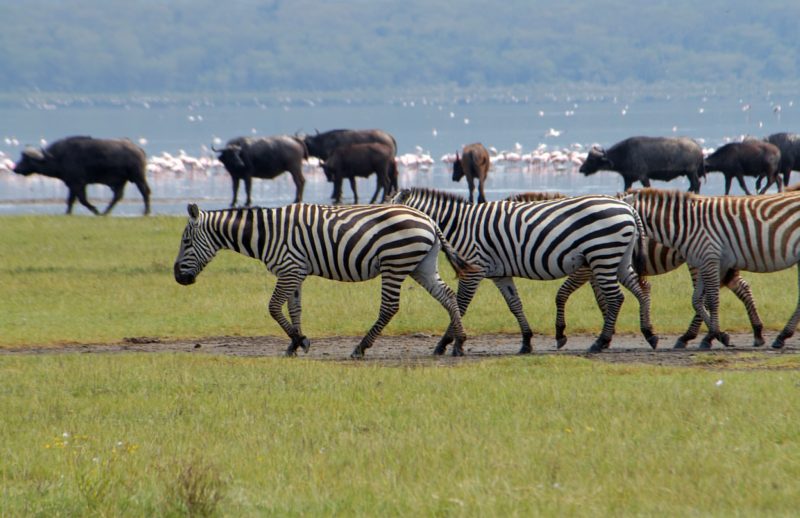
Nakuru National Park is an ideal place for wildlife spotting as it offers sanctuary to 56 species of native African mammals
Lions in Nakuru National Park are relatively few and are not so easy to spot. Baboons, belonging to the genus Papio, can also be seen in Lake Nakuru National Park. They can be surprisingly fast and are often bold enough to come close and grab food from people. They are Arabian and African Old World monkeys. Baboons live in open savannah, woodlands, and hills across Africa. Their diet includes insects and occasionally fish, shellfish, hares, velvet monkeys, birds, and small antelopes if they get to catch one.
Weather and climate
Around the lake, the climate ranges from hot and humid to cool. The annual rainfall is lower than many other areas of Kenya. The dampest months are March to May as well as October to December, but even during these times, it is never as rainy as other parts of the country.
Conservation and sustainability
The organization that protect Lake Nakuru National Park is Kenya Wildlife Service. However, human activities both from outside and within the area still threatens its sustainability. One of the major threats is siltation due to agricultural activities. Pollution from agricultural chemicals like fertilizers, pesticides, herbicides and industrial and domestic effluent from town, enter Lake Nakuru through surface inflows. The development efforts and the tourists visiting the lake are further threatening its biological resources. Lake Nakuru started drying up from the year 1951, and the authorities intervened in 1953 to monitor soda dust.
Ancient yet modern
Although Nakuru is as old as the human civilization, the British settlers modernized it, albeit with its twists and turns. Nakuru National Park protects its many inhabitants from encroachment and poachers and makes it a place conducive to these beings. Thus, Nakuru National Park is not only a traditional bird sanctuary but also a rhino sanctuary as well as a hippo territory and is home to many native African mammals. The region around the lake is put to use for wildlife conservation, and the catchment area land for agriculture, ranching, and forestry. Currently, the Nakuru National Park is run by the Kenya wildlife service.
5 Frequently Asked Questions About Nakuru
To book a safari in Nakuru, please fill out the following form or simply email us on safaris@safari-center.com
